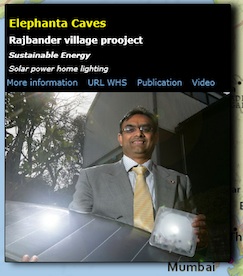Lighting the World Heritage site in India.
 The Rajbander village, on historic Elephanta Island, off the coast of Mumbai, has previously relied on expensive and potentially dangerous kerosene lamps, candles, and diesel. Now, thanks to solar panels the villagers are reducing their carbon footprint and ensuring their power supply for at least the next 10 years. In an initiative led by Mumbai Metropolitan Region Development Authority (MMRDA), the village got an off-grid solar lighting system for their homes.
The Rajbander village, on historic Elephanta Island, off the coast of Mumbai, has previously relied on expensive and potentially dangerous kerosene lamps, candles, and diesel. Now, thanks to solar panels the villagers are reducing their carbon footprint and ensuring their power supply for at least the next 10 years. In an initiative led by Mumbai Metropolitan Region Development Authority (MMRDA), the village got an off-grid solar lighting system for their homes.
The MMRDA led initiative for this LED based solar lighting is supported by the Pune University’s Science and Technology Park (STP) and Solar-Gem, a well known Australia based firm that developed this unique solar energy home lighting solution that promises adequate lighting to every home of Morabandar. The village otherwise gets electricity for 3 hours every evening from a DG set for which each household pays Rs 150 per month, which is used to run TV sets apart from lights and fans. The advantage of the solar system is that the lights will work for almost 5 days even if there is complete cloud cover preventing sunlight, thanks to the specially designed batteries with 10 years of operational life. The lamps are LED based having enclosure design to serve in all adverse environmental conditions with sustainable life of more than 10 years.
The Rs 50 lakh project, largely funded by the Australian government, will not only supply electric power to the homes but also lights the new street lamps that are planned in the village lanes. Dr Peter Beadle and Mr Khimji Vaghjiani of Solar-Gem, Australia, a technology that has won several innovation awards, have developed the core technology.
After signing a Memorandum of Understanding with the Science and Technology Park, in Pune, India, Solar-Gem is implementing a trial where each of the 35 homes in the village is fitted with a rechargeable Light Emitting Diode (LED) unit, providing solar-powered electricity for lights and mobile phones.
Source: SOLAR-GEM















